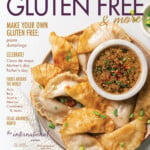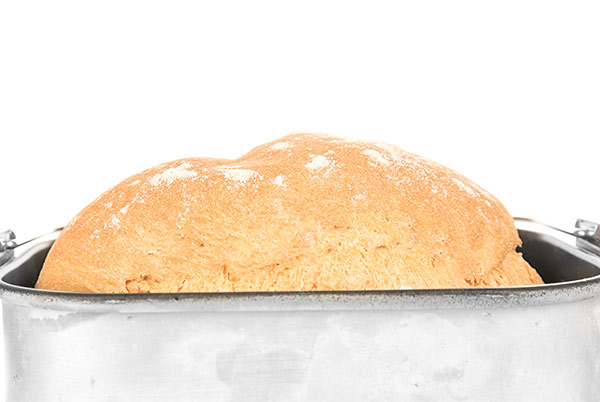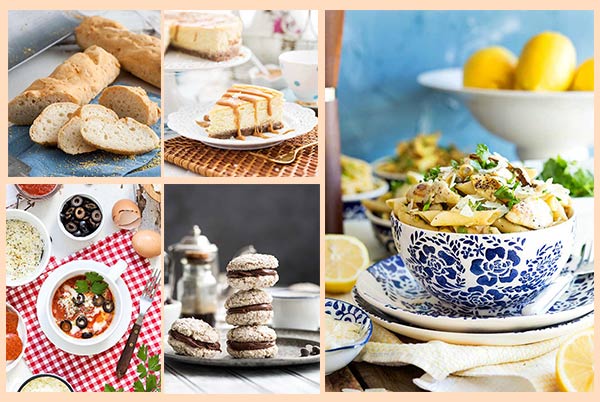This post contains affiliate links. Please see our disclosure policy.
Are you New to Gluten Free? First of all, let me just make this perfectly clear – I am not a doctor! Nor am I a scientist, a nutritionist or any kind of practitioner of any sort – except maybe I perform some black magic in the kitchen! This is just what I have learned from 20 years of research and personal experience. Dr Vikki Petersen wrote the best book I have read on gluten.
Table of Contents
- What is gluten?
- How can gluten affect the body?
- Who has it?
- What’s the cure?
- Where does it hide?
- So … what now?
- Getting Started – The Right Mind Set
- Gluten Free Ingredient Guide
- Gluten Free Travel – My Top 10 Tips
- Answers from a Gluten Doctor – Part 1: Common Symptoms
- ANSWERS FROM A GLUTEN DOCTOR – PART 2: DIAGNOSIS
- Answers from a Gluten Doctor – Part 3: Now What?
- Answers from a Gluten Doctor – Part 4: What About Dairy?
- Answers from a Gluten Doctor – Part 5: Why is it the better we are with diet, the better we have to be?
- Answers from a Gluten Doctor – Part 6: Testing, Testing, Testing
- Answers from a Gluten Doctor – Part 7: Gluten Free Diets and Nutritional Deficiency
- Answers from a Gluten Doctor – Part 8: Supplements
- Answers from a Gluten Doctor – Part 9: The Most Important Thing About Being Gluten Free
- Answers from a Gluten Doctor – Part 10: Gluten Intolerance and Exhaustion
What is gluten?
Gluten is a sticky protein found in wheat, rye and barley. It is also in most oats – not because of the oat itself but because of the way it is processed. Gluten is what makes pizza dough so stretchy, bread rise and pasta hold together.
Remember when you were a kid and you made paper-mache with paper, flour and water? Well, the paper and water were not sticky. The “glue” came from the flour! That’s “gluten.” It’s even the same root word – “glue!”
Gluten is a substance that can make your body pretty ill if you can’t tolerate it.
To get a good a more technical explanation, click here.
How can gluten affect the body?
Well … understanding how it is “glue” gives you a clue now. It gums-up the works! It literally gums-up the lower intestine and food absorption becomes minimized (leaving a person always “hungry”) and a lot of other problems arise.
People who can not tolerate gluten can suffer from a wide variety of ailments including seizures, bloating, intestinal problems, compromised immune systems, depression, anxiety, ADHD (Attention Deficit Hyperactivity Disorder), autism, adrenal exhaustion, and thyroid problems, just to name a few.
Dr. Mark Hyman, MD, a practicing physician, says, “A recent large study in the Journal of the American Medical Association found that people with diagnosed, undiagnosed, and ‘latent’ celiac disease or gluten sensitivity had a higher risk of death, mostly from heart disease and cancer.
This study looked at almost 30,000 patients from 1969 to 2008 and examined deaths in three groups: Those with full-blown celiac disease, those with inflammation of their intestine but not full-blown celiac disease, and those with latent celiac disease or gluten sensitivity (elevated gluten antibodies but negative intestinal biopsy).
The findings were dramatic. There was a 39 percent increased risk of death in those with celiac disease, 72 percent increased risk in those with gut inflammation related to gluten, and 35 percent increased risk in those with gluten sensitivity but no celiac disease.”
Who has it?
Approximately 1 in 130 people has the worst reaction, now labeled “celiac disease” – the most violent reaction in which one can end up in the hospital from gluten intake.
According to the Center for Celiac Research, University of Maryland, an additional 6% (18 million people) may be classified with “gluten sensitivity” or “gluten intolerance” – they get headaches, bloated stomachs, intestinal problems, etc.
In September 2010, on the Oprah Winfrey Show, Dr. Christiane Northrup, author of Women’s Bodies, Women’s Wisdom and The Wisdom of Menopause, stated that 1 out of every 4 women suffer from gluten intolerance.
About a quarter of U.S. adults (25% of the population) are either trying to reduce or completely avoid gluten in their diets, according to the marketing firm, NPD (National Product Development) Group, Inc.
Dr. Hyman says, “But milder forms of gluten sensitivity are even more common and may affect up to one-third of the American population.”
U.S. News and World Report estimates nearly 15 to 25% of consumers are looking for gluten-free products.
Some people find they simply “feel better,” don’t “feel so bloated” after a meal and many commonly find that their diet “all of a sudden works” when they cut out the gluten!
Dr. Mark Hyman adds, “Yet an estimated 99 percent of people who have a problem with eating gluten don’t even know it. They ascribe their ill health or symptoms to something else – not gluten sensitivity, which is 100 percent treatable.
Another study comparing the blood of 10,000 people from 50 years ago to 10,000 people today found that the incidences of full-blown celiac disease increased by 400 percent during that time period. If we saw a 400 percent increase in heart disease or cancer, this would be headline news. But we hear almost nothing about this.”
What’s the cure?
Unfortunately, there is no CURE for gluten intolerance or celiac disease. The only thing you can do is stay away from gluten. Don’t eat it! Most people will start to feel better within days of removing gluten from their diets if they can’t tolerate it. It’s one health issue that you don’t take a pill for! You just stop eating gluten!
Dr. Hyman says, “While testing can help identify gluten sensitivity, the only way you will know if this is really a problem for you is to eliminate all gluten for a short period of time (2 to 4 weeks) and see how you feel.” Get rid of the following foods:
• Gluten (barley, rye, oats, spelt, kamut, wheat, triticale) For a more comprehensive list, go here
• Hidden sources (soup mixes, salad dressings, sauces, as well as lipstick, certain vitamins and medications, stamps and envelopes you have to lick, and even Play-Doh).
“For this test to work you MUST eliminate 100 percent of the gluten from your diet – no exceptions, no hidden gluten, and not a single crumb of bread.
Then eat it again and see what happens. If you feel bad at all, you need to stay off gluten permanently. This will teach you better than any test about the impact gluten has on your body.”
*Please note: if you’re getting tested for celiac disease, it’s important to note that you must be eating gluten to get an accurate test. If you’ve eliminated gluten already and then get tested for celiac, the results could come back with a false negative.
Where does it hide?
Now staying away from gluten sounds simple enough. OK, no more bread, pizza, pasta. Piece of cake (pardon the pun!). Oh, if only it were that simple.
Unfortunately, gluten hides out in many places you would not immediately think … like jelly beans, Popsicles, processed meats, canned tomato soup, soy sauce. A huge amount of processed food contains gluten, as does some lipstick, soaps, shampoos, toothpaste, vitamins, nutritional supplements and medicine.
Some things to look for on food labels include:
- Modified food starch
- MSG
- Lecithins
- Textured vegetable protein
- Emulsifiers
- Caramel color
- Malt
- Soy sauce
For a good list of safe products click here and unsafe products click here.
The point is BEWARE.
Read.
Educate yourself. Don’t just assume that the turkey you are about to put in your mouth is safe. (Yes, some turkey brands contain gluten!!!)
So … what now?
My philosophy is not to focus on what you CAN’T EAT but to focus what you CAN EAT. There is a whole big beautiful world of naturally gluten-free foods out there! Vegetables, fruit, unprocessed meats, most cheeses, fish, seafood.
The world of gluten-free eating is abundant!
There are also really great gluten-free alternatives for breads, cookies, pastries and cakes.
My advice is first stay away from the gluten-free alternatives until your taste buds have a chance to re-adjust or until you find the ones that TASTE GOOD! Continue to experiment. Find the brands you like.
Buy an automatic bread maker and utilize gluten-free bread mixes to enjoy freshly baked gluten-free bread.
Personally, I can live without bread and pasta. What I can’t live without is good health, vigor and energy. Learn to cook gluten free and all the breads and pastas become yours again!
Celebrate the abundance of gluten-free living and the rewards will be plentiful.
You might want to get my booklet (it’s FREE) on Setting Up Your Gluten Free Kitchen.
You can always email me with questions – I read all emails … no auto-responders!
I hope this helps!
Getting Started – The Right Mind Set
New to a gluten free diet? Trust me, I know how you may be feeling at this moment; confused, overwhelmed, and reeling from the enormity of lifestyle change you are about to undertake… Read More
Gluten Free Ingredient Guide
Check out essential gluten free ingredient guide we put together with a list of safe, unsafe and uncertain ingredients… Read More
Gluten Free Travel – My Top 10 Tips
Traveling can be one of the greatest pleasures in life and for the gluten intolerant it can also be one the most challenging… Read More
Answers from a Gluten Doctor – Part 1: Common Symptoms
Meet Dr. Vikki Petersen. Dr. Petersen is a Chiropractor and Certified Clinical Nutritionist, is co-founder and co-director (along with her husband, Dr. Richard Petersen) of the renowned Root Cause Medical Clinic and acclaimed author of the book The Gluten Effect … Read More
ANSWERS FROM A GLUTEN DOCTOR – PART 2: DIAGNOSIS
Continuing with our discussion from highly acclaimed pioneer in the treatment of gluten sensitivity, Dr. Vikki Petersen, we tackle the often confusing subject of diagnosis… Read More
Answers from a Gluten Doctor – Part 3: Now What?
Dr. Vikki Petersen answers the question, “Now what?” and why just eliminating gluten from the diet and home is not enough… Read More
Answers from a Gluten Doctor – Part 4: What About Dairy?
Dr. Vikki Petersen responds to questions about the consumption of dairy by the gluten intolerant… Read More
Answers from a Gluten Doctor – Part 5: Why is it the better we are with diet, the better we have to be?
With a holiday weekend coming up, some of us may be tempted to stray from our gluten-free diets. Dr. Vikki Petersen answers a puzzling question as to why we feel symptoms from gluten so much more AFTER taking gluten out of our diet… Read More
Answers from a Gluten Doctor – Part 6: Testing, Testing, Testing
From the number of emails I received requesting that Dr. Vikki clarify testing for gluten sensitivity, apparently I am not the only one confused… Read More
Answers from a Gluten Doctor – Part 7: Gluten Free Diets and Nutritional Deficiency
Recently there seems to be a lot of misinformation going around, stating that gluten-free diets may be or are causing other nutritional deficiencies… Read More
Answers from a Gluten Doctor – Part 8: Supplements
With the subject of nutritional deficiencies of a gluten free diet cleared up, I thought it’d be best to address the subject of possible supplements… Read More
Answers from a Gluten Doctor – Part 9: The Most Important Thing About Being Gluten Free
Answers from a Gluten Doctor – Part 10: Gluten Intolerance and Exhaustion
Fortunately for me, Dr. Vikki took the time to really get to the bottom of what was going on. It was then we discovered I am gluten intolerant and that the continual eating of gluten-based foods was at the root of my health issues… Read More













